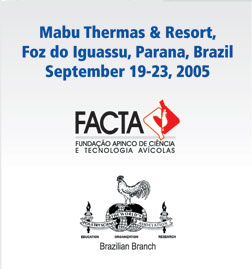Contributed Papers: Oral Presentations
Mixed Cocciodiosis Control: Drugs and Vaccines |
Coccidiosis in
Turkeys: Patterns of sensitivity to diclazuril following
vaccination with Coccivac-T vaccine
Marcelo Lang1; Steve Fitz-Coy
1corresponding author
A series of
trials were conducted to determine the efficacy of
Clinacox (diclazuril) in turkey flocks against isolates
collected from farms using different control programs
for coccidiosis. Isolates of coccidia were collected
from farms that:
(1) Used only Coccivac-T vaccine in the year prior
to collection
(2) Used Clinacox for six months, followed by an ionophore
drug prior to collection
(3) Used Clinacox for six months, followed by Coccivac-T
prior to collection.
Three groups of poults did not receive medication
and were challenged with sporulated oocysts coming
from each of the three sources (infected, unmedicated
controls, IUC). Three groups of poults received feed
with diclazuril and were inoculated with oocysts coming
from one of the above sources. Another group received
diclazuril-free feed and was not challenged, serving
as the unmedicated, unchallenged control (UUC).
Growth rate at the end of 6 days post-challenge was
depressed by an average of 37% on the IUC groups as
compared to the UUC group. The average gross lesion
score of IUC birds was 2.0 and a microscopic parasite
score of 3.27 (range 0 to 4, the higher the score
the greater the severity) was assessed, compared to
no lesions and zero parasite burden in the UUC birds.
Index scores were determined using growth, gross lesions,
microscopic parasitism and livability; A higher index
score indicates better efficacy. The average indexes
for the isolates obtained from source 1 were 40 and
96, for IUC and diclazuril medicated birds, respectively.
The average score for the samples collected from source
2 were 35 and 60, for IUC and diclazuril medicated
birds, respectively. The average score for the samples
collected from source 3 were 35 and 86, for IUC and
diclazuril medicated birds, respectively.
The infectivity of the isolates was severe and similar
on the IUC birds regardless of source. On the other
hand, the response of the isolates to medication with
diclazuril was different. Birds challenged with isolates
from sources 1 and 3 (where Coccivac-T vaccine had
been used) showed better response to medication than
birds challenged with isolates from source 2, where
diclazuril had been used, but no vaccination was applied.
Using Coccivac-T vaccine in rotation with diclazuril
appeared to provide a sparing effect on the efficacy
of the drug.
